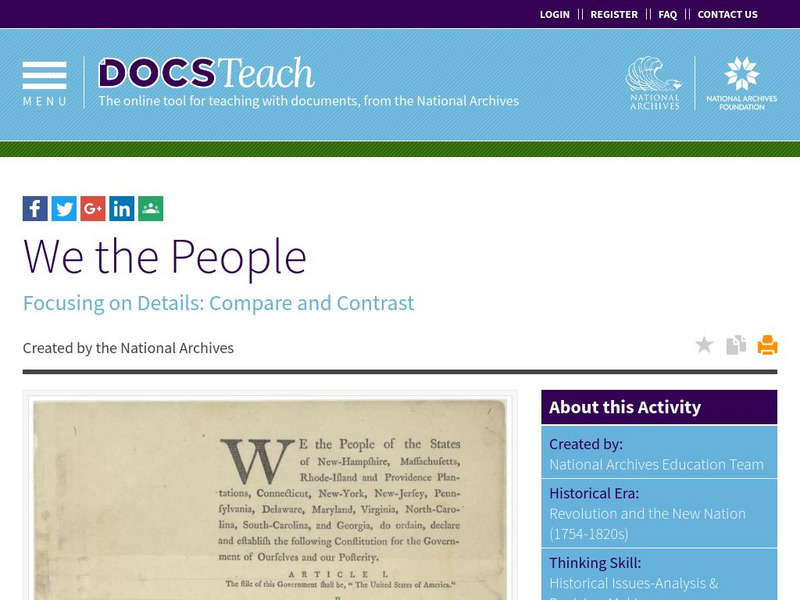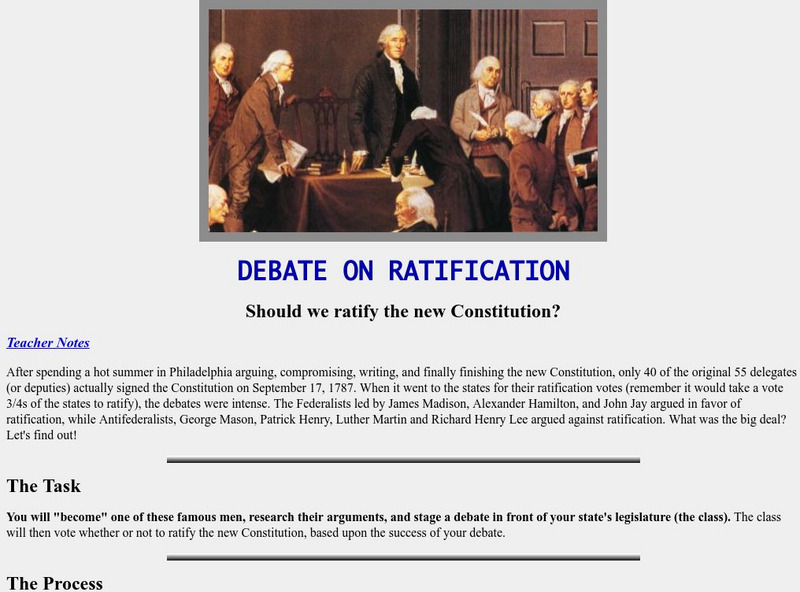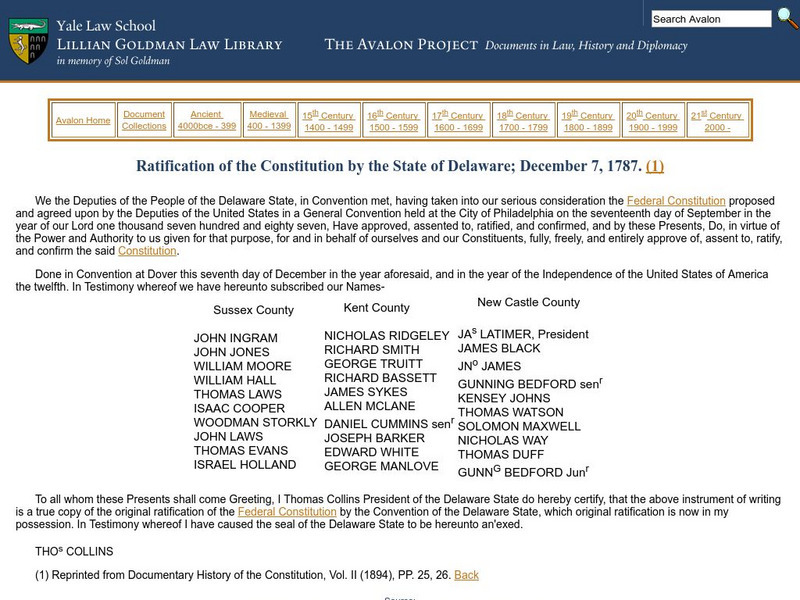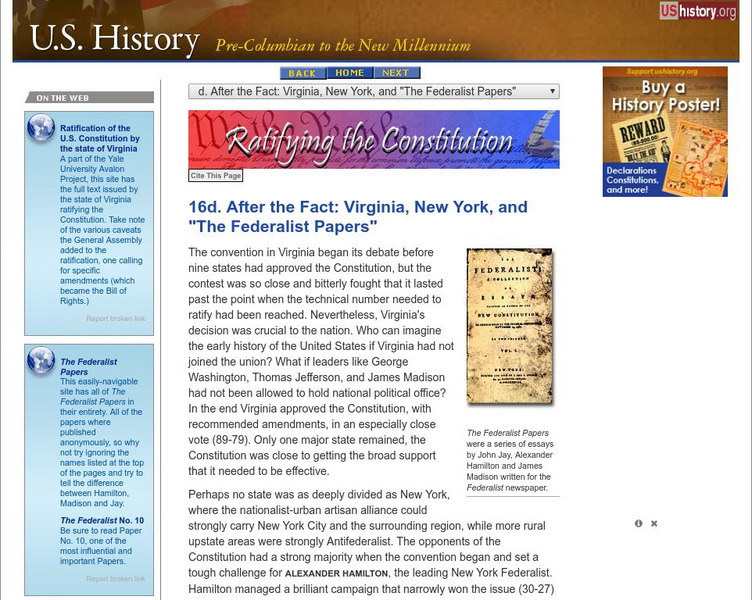Tom Richey
Tom richey.net: The u.s. Constitution: Framing, Principles and Ratification [Ppt]
Presents key ideas for examining how the Articles of Confederation were replaced with the Constitution and the compromises that were reached during debates.
University of Chicago
The Founders' Constitution: Notes From Virginia Ratifying Convention
Edmund Randolph's notes taken at the state convention of Virginia on ratification of the new Constitution.
The Dirksen Congressional Center
Congress for Kids: Ratifying the Constitution
The process for ratifying the United States Constitution is explained in simple terms. Suggestions for research projects, resource links, and some activities are included. The rest of the site has lots more information on the U. S....
US National Archives
National Archives: We the People
View George Washington's annotated draft of the Constitution while discussing the ratification process. Specifically, the students will analyze changes to the Preamble of the Constitution. Critical thinking questions are provided.
iCivics
I Civics: Road to the Constitution
How did we go from thirteen British colonies to the United States of America? Explore the major hardships of life under British rule, how the colonists decided to break away, and how they set a path for a new and independent government....
Schools of California Online Resources for Education
Score: Debate on Ratification
Students become one of the famous men who argued for or against ratification of the Constitution. They research and present their argumets to the class, who will then vote whether or not to ratify the new Constitution.
Siteseen
Siteseen: Government and Constitution: Federalist Papers
The Federalist Papers were a series of 85 essays that promoted the ratification of the United States Constitution and the nature of a Republican government.
Success Link
Success Link: 1787 [Archived Version]
By using the novel, Shh! We're Writing the Constitution by Jean Fritz, and 1787 by Joan Anderson, students learn the lively discussion among the delegates to the Constitutional Convention concerning the ratification of the document they...
Independence Hall Association
U.s. History: The Antifederalists' Victory in Defeat
By 1788 eleven states ratified the Constitution, more than enough to put it into effect as the document establishing rules for the nation. Read about the goals of the Federalists in estabilishing a national government and find out how...
Yale University
Avalon Project: Ratification of the Constitution by the State of Delaware
Language of the ratification of the Constitution of the United States by the legislature of Delaware. Included is a list of the legislators.
ClassFlow
Class Flow: Us Constitution Bill of Rights
[Free Registration/Login Required] In this lesson students explore Amendments 1-10 and discuss the impact of events that led to the ratification of the US Constitution and Bill of Rights. Complete credit page of websites used to create...
Teaching American History
Teaching American History: The Federal Pillars
An overview of the order in which the states ratified the Constitution. Find an assortment of newspaper clippings recognizing the ratification process across the states.
University of Missouri
Exploring Constitutional Conflicts: Women's Fight for the Vote
Find out how women won the right to vote. Read a brief history of the women's suffrage movement and the text of the Nineteenth Amendment.
Yale University
Avalon Project: Resolution of Congress of September 28, 1787
The original text of the resolution of Congress submitting the newly drafted constitution to the states for ratification.
University of Oklahoma
University of Oklahoma Law Library: Federalist Papers
The complete text of the 85 Federalist Papers which explained why the authors believed the new Constitution should be ratified.
iCivics
I Civics: The Federalist Debate
The ratification debate between the Federalists and Anti-Federalists gives us insight into the ideas behind both sides and a better understanding of how our government developed in its early years.
Gilder Lehrman Institute of American History
Gilder Lehrman Institute: The New Nation, 1783 1815
[Free Registration/Login Required] This website documents the United States through its struggles to become a new nation. Site includes primary source documents for the Articles of Confederation, US Constitutional Convention, and George...
Annenberg Foundation
Annenberg Learner: Democracy in America: The Modern Presidency: Tools of Power
This unit details how the role of the President of the United States has evolved to the position it is today since the ratification of the U.S. Constitution. Offers video, readings, web resources and activities.
Scholastic
Scholastic: Explaining the Bill of Rights
Read about the need for a Bill of Rights to be added to the Constitution. Find out what each of the first ten amendments means.
Khan Academy
Khan Academy: Us History: 1754 1800: The Federalist Papers
In the Federalist Papers, Alexander Hamilton, James Madison and John Jay made the case for ratifying the new US Constitution.
Khan Academy
Khan Academy: Us History: 1754 1800: The Bill of Rights
The first ten amendments to the US Constitution guarantee citizens' essential freedoms and rights.
Thomson Reuters
Find Law: Article V: Judicial Review
A discussion of the proposition that ratification of constitutional amendments is exclusively within the purview of Congress, either because of commitment or because the courts lack basic criteria of determination to pass on them.
Stanford University
Sheg: Reading Like a Historian: Federalists & Anti Federalists
[Free Registration/Login Required] Students solve a problem surrounding a historical question by reading primary source documents. This historical inquiry lesson allows students to read Federalist and Anti-Federalist positions from the...
Independence Hall Association
U.s. History: After the Fact: Virginia, New Yok, and "The Federalist Papers"
Read about the necessity for Virginia and New York to support the ratification of the Constitution. See what influenced the vote in Virginia and how the legislature of New York was finally convinced.
![Tom richey.net: The u.s. Constitution: Framing, Principles and Ratification [Ppt] PPT Tom richey.net: The u.s. Constitution: Framing, Principles and Ratification [Ppt] PPT](https://d15y2dacu3jp90.cloudfront.net/images/attachment_defaults/resource/large/FPO-knovation.png)





![Success Link: 1787 [Archived Version] Lesson Plan Success Link: 1787 [Archived Version] Lesson Plan](https://content.lessonplanet.com/knovation/original/501064-ffae068b782fcb5a01d3c7ce2e1a5a66.jpg?1661827526)











